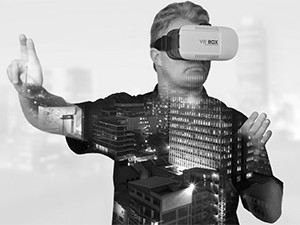
Virtual Reality (VR) has been around since 1957, when Morton Hellig invented the Sensorama. The 1970s saw the development of the Ultimate Display by Ivan Sutherland, and the 1980s made it famous in the sci-fi movie classic, Tron. Fast forward to 2016 and you've got VR on every smartphone and a range of portable headsets - from Oculus Rift to Samsung and Sony to HTC to Google Glass, the big names are all investing in and exploring the technology. As VR continues to evolve, it is extending the experiences felt by users beyond the traditional and into the exceptional, while converging with other technology and industry to create solutions that, quite literally, boggle the mind.
"An immediate area you would think of using VR is in healthcare," says Mark Walker, associate vice-president, IDC Sub-Saharan Africa, Middle East and Turkey, "where you can now provide services from a distance away. Intel was experimenting with this ten years ago, but the technology at that stage was large and cumbersome. With the commercialisation of VR through the likes of Oculus Rift, the price to use sophisticated technology has dropped considerably and the quality is much higher with more bandwidth. Those four vectors are making it a far more viable proposition."
Virtual healthcare
Psychiatrists at the University of Louisville in the USA started experimenting using VR on patients with anxieties and phobias. The controlled virtual environment has allowed for doctors to expose their patients to simulations and help them to find ways of coping with what they are feeling. Virtual reality company, Next Galaxy Corp, has used VR instructional software for certain procedures in partnership with the Nicklaus Children's Hospital and the latter has found that retention levels as a result of the VR training sessions is 80 percent after a year, compared to 20 percent after a week with traditional training methods.
"VR has the potential to make an impact in spaces we never thought possible before," says Dylan Kohlst"adt, founder and CEO of Shift ONE. "It's transforming the way we experience other technology and is being used to develop practical skills in real-time to complement theory. Children can learn and refine sports skills using the power of VR; engineers, firefighters and disaster relief workers can harness it in their daily occupations."
VR has also taken flight. It has already been used in conjunction with drones, but only to varying degrees of useful success. Now, however, VR is stepping into the drone zone with renewed vigour. The Ghost Drone 2.0 by Ehang can be controlled using VR goggles that dictate direction of the drone's camera through head movements. Parrot's Bepop drone is compatible with Oculus Rift, so users get to experience a rather unusual viewpoint throughout the flight.
"In the virtual reality world, we'll be able to take away the limits that we have in the real world," says Gerald Ferreira, co-founder of Virtual-Reality.co.za. "Ever wanted to be Superman? Virtual reality can make this possible. It can be converged with Augmented Reality (AR), where you interact with the real world and see the real world, but elements can be overlaid onto your view. For example, you could be playing games in VR and the monsters appear in the augmented environment, in the real world."
Brands that want to be seen at the forefront of the wave of change are investing in it to create experiences as part of their marketing efforts.
Sheldon Lotter, Platinum Seed
At the recent GamesBeat2015 conference, developers discussing the potential of AR and VR in the gaming environment, concluded that the likely evolution would be a kind of mixed reality where players live and experience both real and virtual worlds.
"The latest VR technologies are developing positive feedback devices and bodysuits that make you feel things in VR," adds Ferreira. "Like the Tesla suit. It uses sensor and electromagnetic pulses to simulate movement, reality and weight and the result is that you feel resistance. One of the stumbling blocks of VR is that there wasn't resistance feedback - now if you pick up a car, you can feel its weight, maybe even struggle to pick it up."
VR can teleport, just like in Star Trek. Want to visit a sporting event in Las Vegas, but can't afford the flights? VR broadcasts are becoming a reality and you need only put on the VR glasses and you're inside the ring, at the stadium and feeling the atmosphere of the crowd.
Immersive expensive
"Virtual reality is a very immersive experience and globally, this technology is still in a phase of exploration and discovery, with filmmakers and technologists experimenting to find new ways of using the technology," adds Sheldon Lotter, creative director, Platinum Seed.
"Brands that want to be seen at the forefront of the wave of change are investing in it to create experiences as part of their marketing efforts."
VR is converging with the traditional in entertainment, gaming, medicine, training, car demos and so much more. Its capability is only limited by technology and price, and those are rapidly being overcome as the VR industry continues to grow at a rapid rate, with revenue predicted to increase from $90 million in 2014 to $5.2 billion by 2018.
This article was first published in the May 2016 edition of ITWeb Brainstorm magazine. To read more, go to the Brainstorm website.
Share